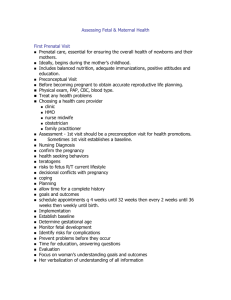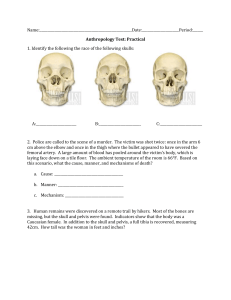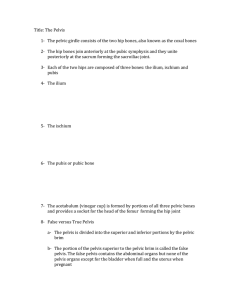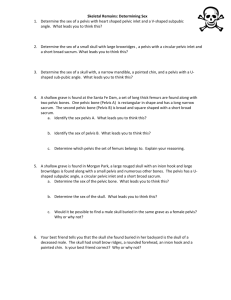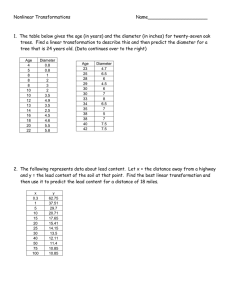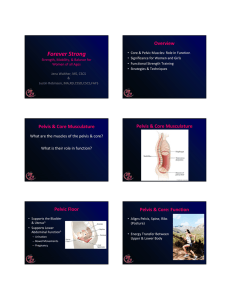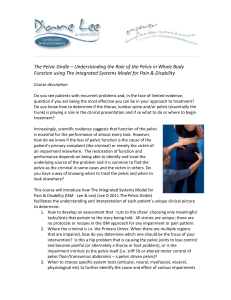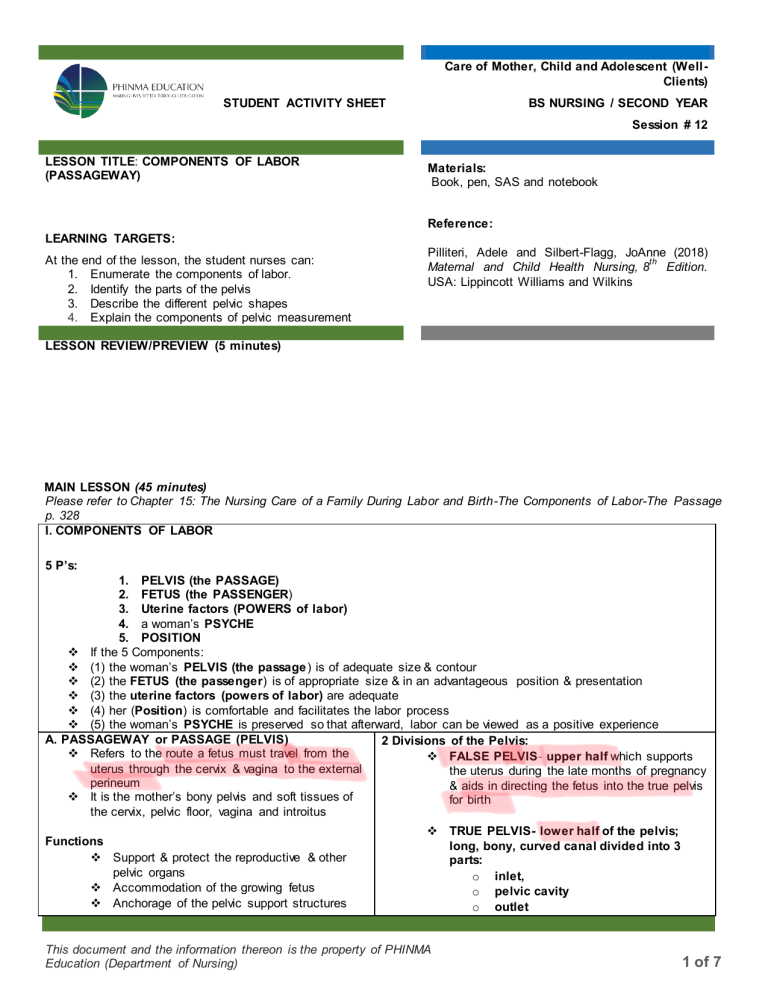
Care of Mother, Child and Adolescent (WellClients) STUDENT ACTIVITY SHEET BS NURSING / SECOND YEAR Session # 12 LESSON TITLE: COMPONENTS OF LABOR (PASSAGEWAY) Materials: Book, pen, SAS and notebook Reference: LEARNING TARGETS: At the end of the lesson, the student nurses can: 1. Enumerate the components of labor. 2. Identify the parts of the pelvis 3. Describe the different pelvic shapes 4. Explain the components of pelvic measurement Pilliteri, Adele and Silbert-Flagg, JoAnne (2018) th Maternal and Child Health Nursing, 8 Edition. USA: Lippincott Williams and Wilkins LESSON REVIEW/PREVIEW (5 minutes) MAIN LESSON (45 minutes) Please refer to Chapter 15: The Nursing Care of a Family During Labor and Birth-The Components of Labor-The Passage p. 328 I. COMPONENTS OF LABOR 5 P’s: 1. PELVIS (the PASSAGE) 2. FETUS (the PASSENGER) 3. Uterine factors (POWERS of labor) 4. a woman’s PSYCHE 5. POSITION If the 5 Components: (1) the woman’s PELVIS (the passage) is of adequate size & contour (2) the FETUS (the passenger) is of appropriate size & in an advantageous position & presentation (3) the uterine factors (powers of labor) are adequate (4) her (Position) is comfortable and facilitates the labor process (5) the woman’s PSYCHE is preserved so that afterward, labor can be viewed as a positive experience A. PASSAGEWAY or PASSAGE (PELVIS) 2 Divisions of the Pelvis: Refers to the route a fetus must travel from the FALSE PELVIS- upper half which supports uterus through the cervix & vagina to the external the uterus during the late months of pregnancy perineum & aids in directing the fetus into the true pelvis It is the mother’s bony pelvis and soft tissues of for birth the cervix, pelvic floor, vagina and introitus Functions Support & protect the reproductive & other pelvic organs Accommodation of the growing fetus Anchorage of the pelvic support structures TRUE PELVIS- lower half of the pelvis; long, bony, curved canal divided into 3 parts: o inlet, o pelvic cavity o outlet This document and the information thereon is the property of PHINMA Education (Department of Nursing) 1 of 7 Composition Anterior & lateral portion made up of 2 innominate hip bones divided into 3 parts (ilium, ischium and pubis LINEA TERMINALIS or BRIM- imaginary line from the sacral promontory to the superior border of the SP which divides the pelvis into true & false pelves Posterior portion: sacrum, coccyx 1. Types of Female Pelvic Shapes c. Anthropoid- “APE-LIKE” This document and the information thereon is the property of PHINMA Education (Department of Nursing) 2 of 7 a. Gynecoid Pelvis “FEMALE” Has an inlet that is well-rounded and has a wide pubic arch Ideal for childbirth b. Android- “MALE” The pubic arch forms an acute angle, making the lower dimensions of the pelvis extremely narrow A fetus may have difficulty exiting from this type of pelvis It’s transverse diameter is narrow; the anteroposterior diameter of the inlet is larger than usual. Even though the inlet is large, the shape of the pelvis does not accommodate a fetal head as well as the gynecoid pelvis d. Platypelloid – “Flattened” (oval) It has a smoothly-curved oval inlet, but the anteroposterior diameter is shallow. A fetal head might not be able to rotate to match the curves of the pelvic cavity 2. ESTIMATING PELVIC SIZE (PELVIMETRY) 2 important pelvic measurements to determine the adequacy of the pelvic size: • the DIAGONAL CONJUGATE (anterior-posterior diameter of the inlet) • the TUBERO-ISCHIAL or BI-ISCHIAL DIAMETER (transverse diameter of the outlet) DC (Diagonal conjugate) is the narrowest diameter of the inlet & the (TD) Tubero-ischial Diameter is the narrowest diameter of the outlet (11.5 cm) TD of pelvic cavity/inter-spinous diameter= 10 cm TD of outlet/bi-ischial diameter= 11.5 Anteroposterior Measurements of the Inlet a. DIAGONAL CONJUGATE= 10.5 - 11 cm. o It is the measurement between the anterior surface of the sacral prominence (sacral promontory) and the posterior surface (inferior margin) of the symphysis pubis o measured by internal examination; AP diameter b. OBSTETRIC CONJUGATE= > 10 cm. o o Measurement of the Transverse Diameter of the Outlet a. TUBERO-ISCHIAL or BI-ISCHIAL Diameter of the Outlet It is the distance between the ischial tuberosities, or the transverse diameter of the outlet (the narrowest diameter at that level, ot the one most apt to cause a misfit) It is made at the medial and lowermost aspect of the ischial tuberosities, at the level of the anus Diameter of 11 cm is considered adequate because it will allow the widest diameter of the fetal head, or 9 cm, to pass freely through the outlet It is the distance between the midpoint of the sacral promontory & the midline of the symphysis pubis which is ascertained by subtracting 1 to 1.5 cm from the diagonal conjugate OC= DC – 1 to 1.5 This document and the information thereon is the property of PHINMA Education (Department of Nursing) 3 of 7 c. TRUE CONJUGATE/CONJUGATA VERA= > 11 cm. o It is the distance between the midpoint of the sacral promontory and the upper or superior margin of the symphysis pubis CHECK FOR UNDERSTANDING (25 minutes) You will answer and rationalize this by pair. This will be recorded as your quiz. One (1) point will be given to correct answer and another one (1) point for the correct ratio. Superimpositions or erasures in you answer/ratio is not allowed. Multiple Choice 1. Which of the following factors affecting labor is associated with passageway? A. Size of the fetal head and its ability to mold to the maternal pelvis B. The presentation of the fetus in relation to the maternal pelvis C. The structure of the maternal pelvis D. The frequency, duration and strength of the contraction ANSWER: ________ RATIO:__________________________________________________________________________________________ _________________________________________________________________________________________________ _______________________________________________________________ _______________________ 2. Which of the following pelvis is round in shape, the most common type of pelvis among females and allows fetus to pass with ease? A. Anthropoid B. Gynecoid C. Platypelloid D. Android ANSWER: ________ RATIO:__________________________________________________________________________________________ _________________________________________________________________________________________________ _______________________________________________________________ _______________________ 3. Which of the following diameters will pose a problem for vaginal delivery? A. True conjugate 11.5 cm or greater B. Transverse diameter of inlet less than 12 cm. C. Oblique diameter of the inlet is 12.7 cm or greater D. Anteroposterior diameter of the outlet is 11.7 or greater ANSWER: ________ RATIO:__________________________________________________________________________________________ _________________________________________________________________________________________________ ______________________________________________________________________________________ 4. It is the measurement between the anterior surface of the sacral prominence (sacral promontory) and the posterior surface (inferior margin) of the symphysis pubis A. Diagonal conjugate B. Obstetric conjugate C. True conjugate D. Bi-ischial conjugate ANSWER: ________ RATIO:__________________________________________________________________________________________ _________________________________________________________________________________________________ _______________________________________________________________ _______________________ 5. It refers to the route a fetus must travel from the uterus through the cervix & vagina to the external perineum A. Passageway B. Passenger C. Powers D. Psyche ANSWER: ________ This document and the information thereon is the property of PHINMA Education (Department of Nursing) 4 of 7 RATIO:__________________________________________________________________________________________ _________________________________________________________________________________________________ _______________________________________________________________ _______________________ 6. It is the upper half of the pelvis which supports the uterus during the late months of pregnancy & aids in directing the fetus into the true pelvis for birth A. Inlet B. Outlet C. False pelvis D. True pelvis ANSWER: ________ RATIO:__________________________________________________________________________________________ _________________________________________________________________________________________________ _______________________________________________________________ _______________________ 7. It is a landmark of the midpelvis and is important for determining engagement A. symphysis pubis B. iliac crest C. Ischial tuberosities D. Ischial spines ANSWER: ________ RATIO:___________________________ _______________________________________________________________ _________________________________________________________________________________________________ ______________________________________________________________________________________ 8. These are functions of the pelvis except: A. Support & protect the reproductive & other pelvic organs B. Accommodation of the growing fetus C. Anchorage of the pelvic support structures D. Nourishment of the growing fetus ANSWER: ________ RATIO:__________________________________________________________________________________________ _________________________________________________________________________________________________ _______________________________________________________________ _______________________ 9. It is a the most reliable measurement of the outlet A. Bi-ischial diameter B. Diagonal conjugate C. Obstetric conjugate D. True conjugate ANSWER: ________ RATIO:__________________________________________________________________________________________ _________________________________________________________________________________________________ _______________________________________________________________ _______________________ 10. It is the condition where the fetal head cannot fit into the diameters of the maternal pelvis; thus, necessitating a C-section A. Dystocia B. Cephalopelvic disproportion (CPD) C. False labor D. second stage arrest ANSWER: ________ RATIO:__________________________________________________________________________________________ _________________________________________________________________________________________________ ______________________________________________________________________________________ This document and the information thereon is the property of PHINMA Education (Department of Nursing) 5 of 7 RATIONALIZATION ACTIVITY (THIS WILL BE DONE DURING THE FACE TO FACE INTERACTION) The instructor will now rationalize the answers to the students. You can now ask questions and debate among yourselves. Write the correct answer and correct/additional ratio in the space provided. 1. ANSWER: ________ RATIO:_______________________________________________________________________________________ _____________________________________________________________________________________________ _____________________________________________________________________ 2. ANSWER: ________ RATIO:_______________________________________________________________________________________ _____________________________________________________________________________________________ _____________________________________________________________________ 3. ANSWER: ________ RATIO:_______________________________________________________________________________________ _____________________________________________________________________________________________ _____________________________________________________________________ 4. ANSWER: ________ RATIO:_______________________________________________________________________________________ _____________________________________________________________________________________________ _____________________________________________________________________ 5. ANSWER: ________ RATIO:_______________________________________________________________________________________ _____________________________________________________________________________________________ _____________________________________________________________________ 6. ANSWER: ________ RATIO:_______________________________________________________________________________________ _____________________________________________________________________________________________ _____________________________________________________________________ 7. ANSWER: ________ RATIO:_______________________________________________________________________________________ _____________________________________________________________________________________________ _____________________________________________________________________ 8. ANSWER: ________ RATIO:_______________________________________________________________________________________ _____________________________________________________________________________________________ _____________________________________________________________________ 9. ANSWER: ________ RATIO:_______________________________________________________________________________________ _____________________________________________________________________________________________ _____________________________________________________ ________________ 10. ANSWER: ________ RATIO:_______________________________________________________________________________________ _____________________________________________________________________________________________ _____________________________________________________________________ LESSON WRAP-UP (5 minutes) You will now mark (encircle) the session you have finished today in the tracker below. This is simply a visual to help you track how much work you have accomplished and how much work there is left to do. You are done with the session! Let’s track your progress. 1 2 3 Period 1 4 5 6 7 8 9 10 11 Period 2 12 13 14 15 16 17 18 19 Period 3 20 21 22 23 AL STRATEGY: CAT 3-2-1 This closure activity is to evaluate what you had learned after the discussion and the activity . This document and the information thereon is the property of PHINMA Education (Department of Nursing) 6 of 7 3-2-1 Three things you learned: 1. __________________________________________________ 2. __________________________________________________ 3. __________________________________________________ Two things that you’d like to learn more about: 1. __________________________________________________ 2. __________________________________________________ One question you still have: 1. ___________________________________________ For next session: Kindly read Please refer to Chapter 15: The Nursing Care of a Family During Labor and Birth-The Components of Labor-The Passenger p. 329 This document and the information thereon is the property of PHINMA Education (Department of Nursing) 7 of 7

